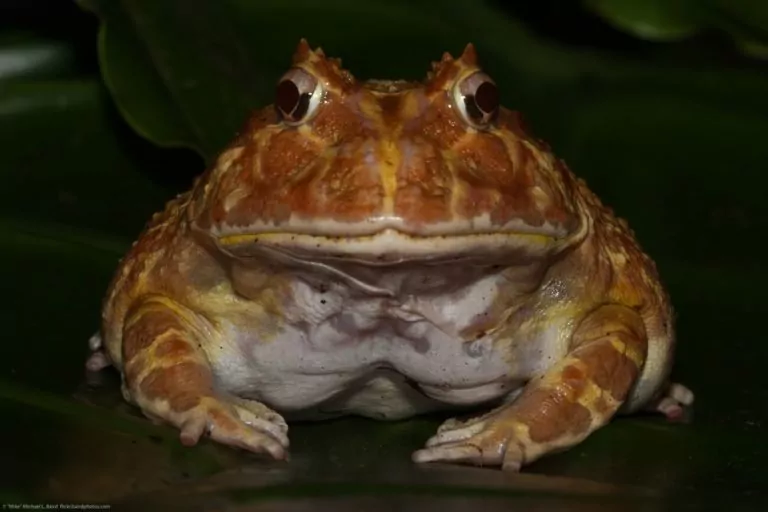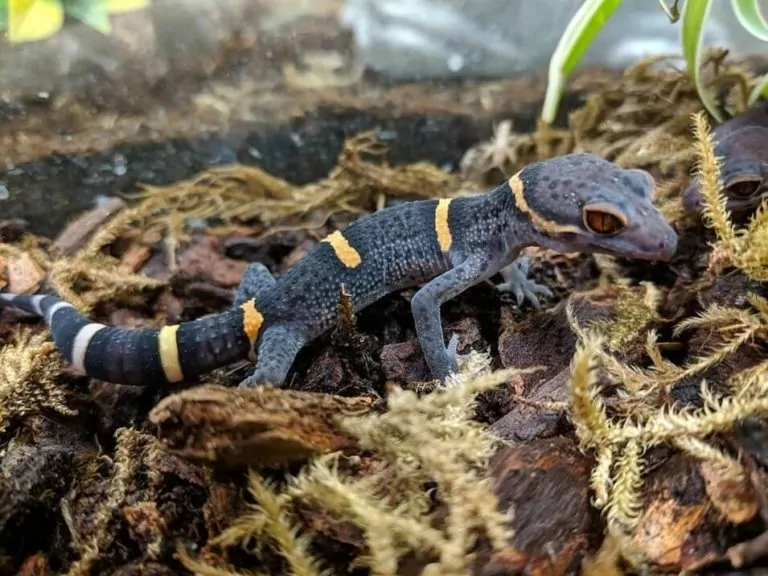Jeweled lacertas are gorgeous reptiles with a unique look that really makes them stand out. They’re also quite active and fun to observe, which means they’re quite a joy to own!
But these lizards can be a bit finicky, which means it’s important for you to have a firm understanding of their requirements if you want them to thrive.
This guide will teach you everything you need to know about jeweled lacerta care, so you’ll be ready for ownership on day one!
Table of Contents
Species Summary
The jeweled lacerta (Timon lepidus) is also sometimes called the ocellated lizard or the jeweled lizard. You’ll find this lovely lizard in Spain, Portugal and parts of France and Italy. They favor areas like vineyards, rocky areas, woodlands and olive groves.
These diurnal lizards are quite shy and don’t do well with too much handling. Their tendency toward stress and their care requirements make this lizard the perfect match for intermediate to advanced caretakers.
This lizard is threatened, so make sure that you are purchasing one that has been bred in captivity. It is illegal to capture and sell one from the wild due to the devastating effect it can have on their natural population.
Appearance & Colors
One look at the jeweled lacerta, and you’ll know why these stunning lizards are so coveted by reptile lovers. Jeweled lacertas have bright-green bodies that are overlaid with jewel-like blue spots and darker rosettes.
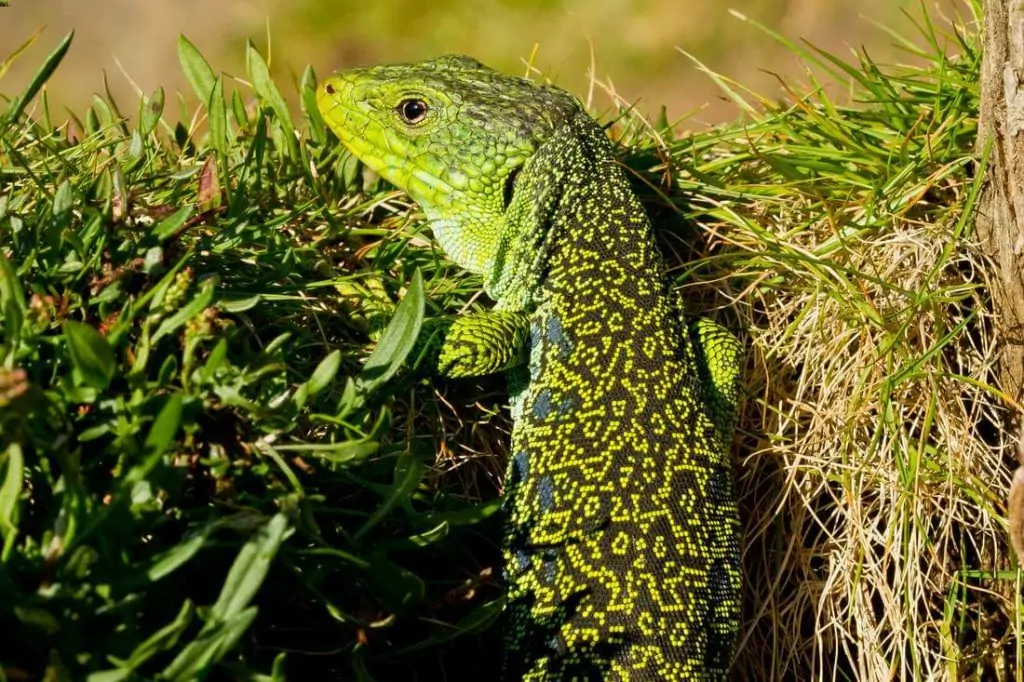
This makes their skin look like it’s covered in jewels or colorful beads. It becomes even more spectacular when you watch them move around!
In comparison to the skin on their bodies, the head of a jeweled lacerta is actually rather plain. The jeweled appearance gives way to more standard reptile scales and less color variation.
Expert Tip: Male jeweled lacertas are typically bigger than females, and they have larger heads and slightly brighter coloring. All jeweled lacertas have strong legs, long toes, strong claws and large tails.
Average Jeweled Lacerta Size
The typical jeweled lacerta size is 24 inches in length for adult males, and 16 to 20 inches for females. This measurement includes the length of their tail as well.
There are a number of factors that can impact the size of your jeweled lacerta, but care and genetics are the main ones. If you provide these pet lizards with excellent care and purchase them from a trustworthy seller, they will probably grow quite large!
Lifespan
The average jeweled lacerta lifespan is between 12 and 20 years when given proper care. As you can see, the upper end of that range is quite a long time!
Expert Tip: Before deciding to care for one of these beautiful lizards, it’s a good idea to take their unique care needs and long lifespan into consideration. If you’re not up to the task, then it may be a good idea to find something easier to care for (there’s no shame in that).
However, if you do feel confident, then you will have a pet that can bring many years of enjoyment and satisfaction.
Jeweled Lacerta Care
There are some aspects of jeweled lacerta care that are simple, and others that can be rather tricky.
Like many other lizards, the jeweled lacerta has some very specific temperature, humidity, lighting and feeding requirements. This pet reptile is also very easily stressed and does not like to be handled.
For these reasons, this species is recommended for intermediate to advanced reptile caretakers only.
Enclosure Size
To keep your jeweled lacerta safe and comfortable, you’ll need to provide it with a fairly large enclosure. Their gender will also dictate the ideal size you should prepare.
Here are the appropriate sizes for males and females:
- Male lacertas require an enclosure with a minimum size of 4 by 2 by 3 feet, or you can simply use a 40 gallon tank.
- Females, because they are a little smaller, can be housed in an enclosure that’s 3 by 2 by 2 feet.
- If you have the room, feel free to make the enclosure even larger!
Front-opening enclosures seem to be best for jeweled lacertas, but a top-loading one that has a sturdy lid is acceptable as well.
It’s best to house these reptiles in their own enclosures. Males that are housed together will usually become aggressive and may fight for food and territory. Males and females should only be housed together briefly for mating purposes. The male can be a bit overzealous in the love department and will often hurt the female.
Expert Tip: If you have hatchlings, put them in their own tanks as soon as possible. Stronger hatchlings will sometimes kill weaker ones, so it’s best to separate them before this happens.
Habitat Setup
Jeweled lacertas are burrowers, so choosing the right kind of substrate is going to be very important. We like using coco mulch or play soil.
You can use a combination of these, or you can even add potting soil to the mix. Just make sure that your substrate is at least six inches thick.
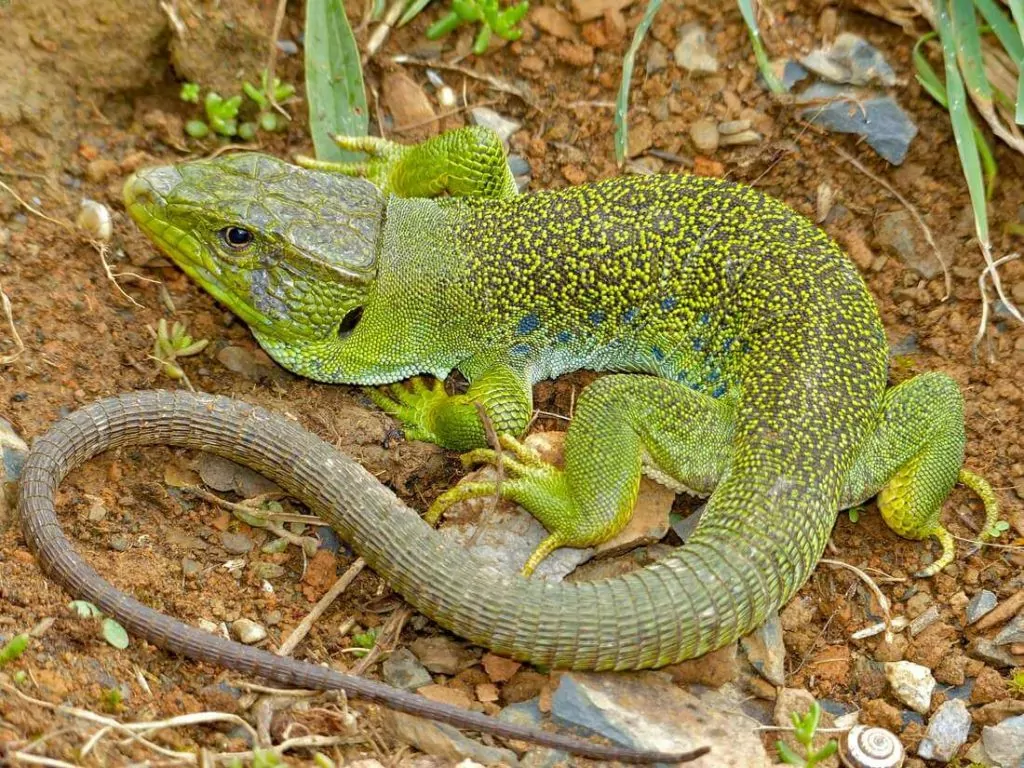
As far as other enclosure enhancements go, you don’t need anything complicated. Jeweled lacertas like to climb, so you can add some branches or pieces of wood to the basking end of the enclosure.
Artificial plants are a nice touch, and a couple of reptile hides are a must. Some people add rocks, but make sure that you place the rocks on the base of the enclosure and not on top of the substrate.
Expert Tip: Taking the time to set up a respectable habitat will make a big impact on the overall health and happiness of these lizards. It’s no coincidence that the specimens with the longest lifespan tend to have the best habitats!
Temperature & Lighting
As with so many lizards in captivity, the jeweled lacerta needs a temperature gradient within the enclosure. This means that one end of the habitat will be the warmer, basking side, and the other side will be the cool-down side.
Using a heat source (such as a ceramic heat lamp or a halogen light), create a basking temperature of between 90 and 95 degrees Fahrenheit on one side of the tank. This is also where you will be placing the branches and pieces of wood.
The rest of the enclosure can remain around 75 to 85 degrees Fahrenheit.
Expert Tip: Make sure that the heat source is not too close to the basking area. You don’t want your lizard to get a burn.
Your jeweled lacerta will require a supplemental source of UVB lighting as well. This helps to prevent metabolic bone disease as well as other health issues.
We recommend a mercury vapor bulb to provide heat, UV light and regular light at the same time. But as long as your lizard is getting the amount of light it needs, then it doesn’t really matter which type of light source you use.
Humidity
There’s not a lot required when it comes to the required humidity levels in their enclosure. Mist the enclosure a couple of times a day, keep the level between 50 and 60 percent, and you should be fine.
It’s important for you to invest in a reliable and accurate hygrometer. This will allow you to quickly monitor the humidity and make adjustments as needed..
Water
Make sure that your jeweled lacerta has plenty of clean, fresh water inside the enclosure. This can be achieved through misting the enclosure and by placing a bowl of water somewhere in the enclosure.
This water source will also help provide some consistency when it comes to humidity as well, making your job a little easier.
Expert Tip: The water bowl should be heavy enough to not get tipped over, and you’ll need to put it in such a way that your lizard won’t keep getting substrate in it.
Feeding & Diet
Jeweled lacertas are basically insectivores, but they will also enjoy the occasional bit of fruit. Some recommended food items include crickets, dubia roaches, mealworms, superworms, butter worms and garden snails.
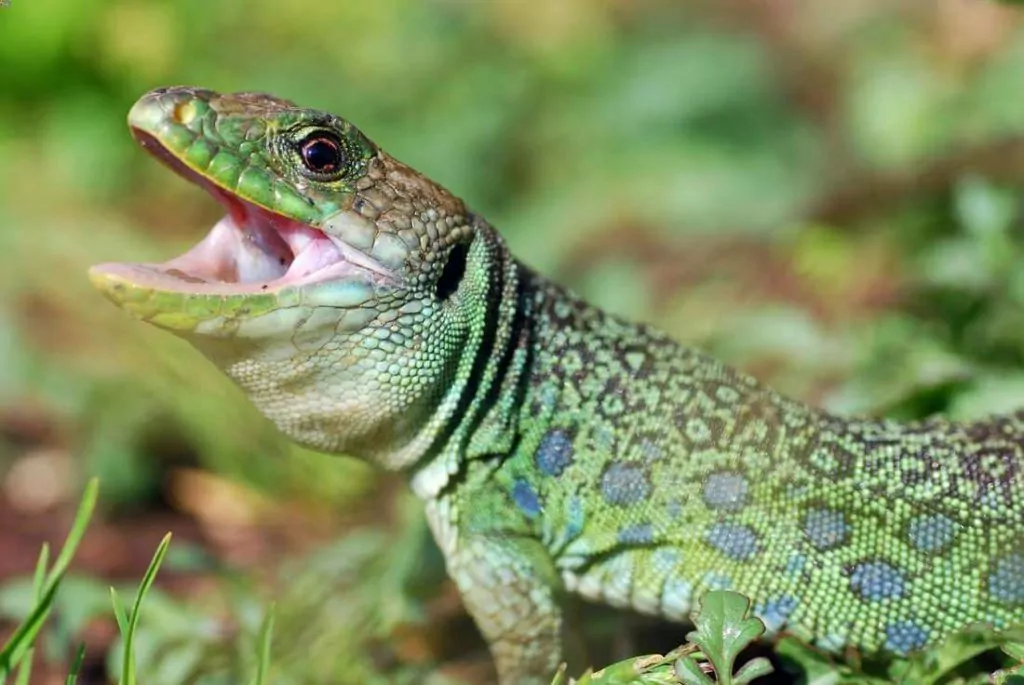
These lizards like to hunt their prey, so you should feed them live food if possible. This provides vital enrichment that can make a big difference on the overall happiness and comfort of your pet.
Jeweled lacertas should be fed once a day, and you should only give them as much as they can eat in one sitting. Remove all uneaten prey from the enclosure. Dust the prey with supplemental calcium and vitamin D3 powder.
Fruit, such as mashed bananas, mangoes or strawberries, can be given in small doses. Moderation is important here, since too much can lead to digestive issues.
Potential Health Issues
Jeweled lacertas suffer from many of the same health issues as other pet lizards. Potential health issues include metabolic bone disease, an overdose of vitamins, parasites, impaction and skin issues.
Fortunately, you can significantly reduce the risk of your lizard suffering from any of these by simply providing them with great care. Adequate humidity, lighting, and diet go a long way!
These lizards are usually pretty healthy, so if you notice lethargy, lack of appetite, mouth sores or mucus, get your lizard checked immediately. A veterinarian, who is familiar with exotics, is going to be an important part of keeping your jeweled lacerta healthy and happy.
Expert Tip: Regularly cleaning the enclosure is another thing you can (and should) do to prevent bacteria and other nasty sicknesses from plaguing your jeweled lacerta. Spot clean throughout the week, and do a formal cleaning every week or two.
Behavior & Temperament
These lizards are quite shy and tend to be very peaceful and calm in general. They will bite if afraid or overly excited, but this is not common behavior. Males can be aggressive with each other (and males get pretty riled up around mating time) but they are pretty mellow lizards overall.
Jeweled lacertas are diurnal and partially arboreal. During the day they can be seen hunting, burrowing, basking and exploring their enclosure.
They are relatively active which makes them a great species to observe. You’ll get a front-row seat to their interesting colors and patterns as they move around the enclosure.
Handling Tips
If you are looking for a pet that tolerates being handled, then the jeweled lacerta is not for you. This shy lizard is very easily stressed, and it may drop its tail if it’s handled too much! While some owners have been able to pull this off, it’s not something that should be done often.
A new jeweled lacerta will be very shy, and you will need to give it quite some time to get used to you. Once it associates you with food, it will become more relaxed and even welcome your presence.
The best thing for your jeweled lacerta’s overall health is to not handle it at all. It will be quite happy to be left in peace to enjoy its surroundings.
Expert Tip: If you do need to handle your lizard, place a towel over it and gently lift it from under its body. This technique will come in handy if you need to take them to the vet or make changes to their enclosure.
Conclusion
Jeweled lacerta care can be quite manageable for owners with a little bit of experience. As long as you understand their core requirements and commit to giving them the appropriate amount of attention, these lizards will be just fine.
If there’s anything that we didn’t cover in this care sheet that you need some help with, feel free to ask us!

